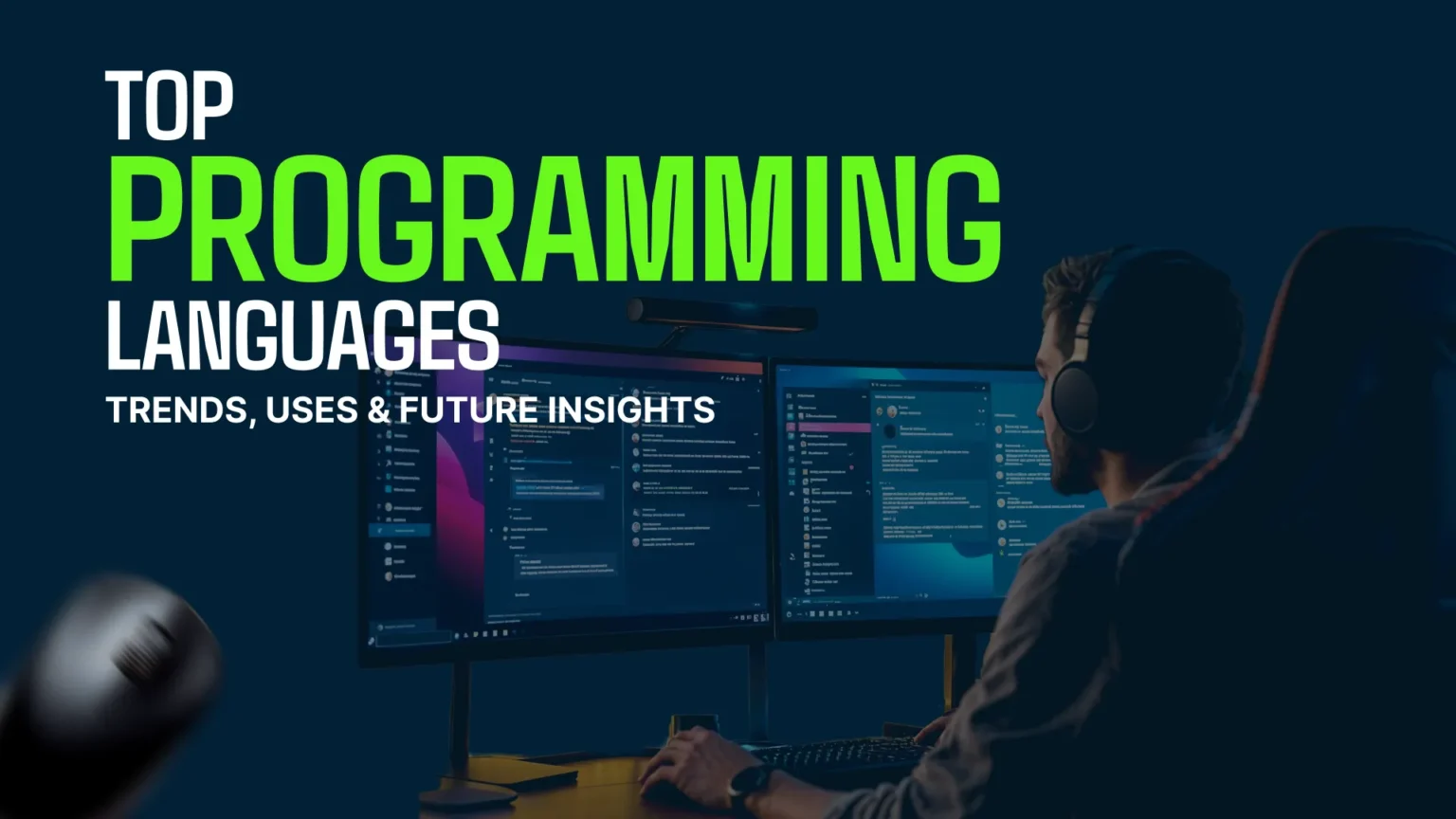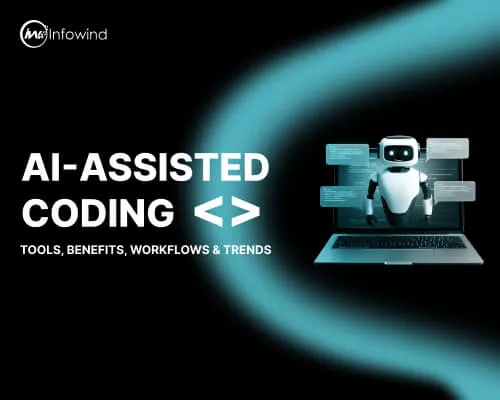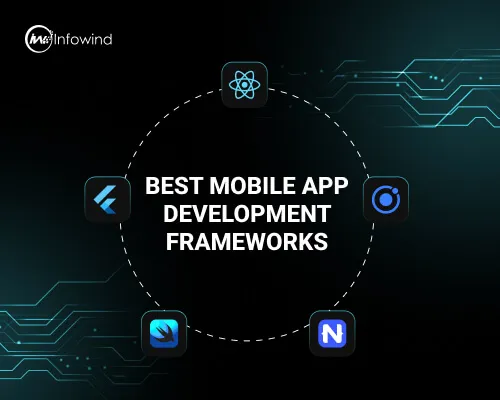Using the correct programming language stands as the most critical choice for developers in 2025. The selection of a programming language that fits emerging trends due to quick technological progress will considerably affect your professional development. Learning the correct programming language at this time will determine your future success in the technological world.
Programming languages continue to evolve so Python, JavaScript, and Java together with Java will maintain their status as the most commonly used languages by 2025. In 2024 Stack Overflow reported that Python serves as developers’ standard programming language for data science and artificial intelligence applications because 70% of programmers rely on it. For web development purposes JavaScript continues to dominate the market because approximately 70% of developers rely on it for their projects. Universal language selection provides developers with access to extensive employment prospects together with a dynamic programmer community.
Popular coding languages exhibit maximum versatility to make them the best choices. Python provides superior simplicity alongside remarkable power which establishes it as a useful programming language for all development needs from web creation to machine learning.
This platform delivers an analysis of the programming languages that will dominate 2025 considering both current demand patterns and possible business expansion. The complete list of best programming languages for today’s competitive tech landscape will be explained in detail.
How We Ranked These Programming Languages
Language selection goes beyond syntax since different factors need evaluation for making the best decision. Our research of programming language popularity depended on how they applied to real-world needs and available professional opportunities as well as their anticipated future developments. We established these criteria to rank programming languages at different points.
1. Industry Demand and Job Opportunities
Best Programming languages with profitable job opportunities are the most beneficial for programmers. The technology sector mainly relies on Python along with Java javascript and C++ as these languages appear frequently in global job advertisements. Web development together with enterprise application development and emerging technology projects make up their entire scope of demand.
2. Versatility Across Industries and Platforms
Programming languages that are most helpful enable the creation of multiple different applications. The programming language Python leads data science and AI work while JavaScript controls all aspects of development from front-end to full-stack and Java provides the best solution for enterprises and mobile applications. C# and Swift provide support for mobile app development and gaming applications thus expanding their application reach.
3. Performance and Scalability
Large-scale applications require performance as their fundamental factor. C++ Rust and Go demonstrate high operational efficiency along with processing speed which makes them perfect for high-performance computing tasks backend development and system-level tasks.
4. Community Support and Ecosystem
A student should select the best coding language that maintains a robust developer community while offering vast libraries and framework options. Three programming languages namely JavaScript Python and PHP maintain substantial developer communities through which they access constant updates and ample resources for learning.
5. Emerging Trends: AI, ML, and Data Engineering
Programming languages that form the foundation of the future include Python as well as R and SQL for their respective purposes. These programming languages hold essential value in automation and analytics making these programming languages in high demand.
According to our evaluation of these criteria, we selected the prominent most useful programming languages that will determine the future of technology thus helping you select the proper skills for advancing your career.
Top 50 Programming Languages: In-Depth Overview
The digital world depends on programming languages’ popularity to serve as foundations during software development. Novice or experienced developers who want to enter coding should select a programming language because it determines their path. The research examines the top 50 programming languages while focusing on leading mobile app development languages active in the current market.
Mobile App Development Languages
Mobile applications are vital to our daily lives since they enable all the features of social media and fintech solutions. The selection of the proper language determines application performance, scalability features, and user interface experience. The following section details the most effective mobile app development languages operating within the tech ecosystem.
1. Flutter – Cross-Platform Development with a Single Codebase
The mobile development field encountered a breakthrough through Google’s creation of Flutter. This technology’s single codebase feature enables developers to generate native applications that run on all platforms, including mobile, web, and desktop, at once. The Dart programming language behind Flutter enables developers to achieve perfect cross-platform UI results from one code base.
- The main advantages of Flutter are hot reload abilities together with expressive interfaces that operate at exceptional speeds.
- The three platforms utilizing Flutter include Google Ads together with Alibaba and eBay Motors.
2. Swift (iOS) – The Powerhouse of iOS Development
Apple created Swift as its proprietary language to build applications for all platforms including iOS macOS watchOS and tvOS. Swift provides developers with a modern syntax alongside speed and safety features which substitutes Objective-C with familiar code syntax that improves both execution speed and readability.
- The main advantages of this language include both memory safety together with native integration of iOS frameworks and high operational performance.
- The programming language provides its services to LinkedIn as well as Airbnb and Lyft.
3. Kotlin (Android) – The Official Android Language
The concise expressive platform of Kotlin has surged in popularity since it became the main Android development language by replacing Java because of its null-safe structure and compact nature. The official backing from Google makes Kotlin improve application reliability and worker productivity.
- Kotlin provides three essential advantages including it can work with Java using its features while developers write less repetitive code and their applications become more dependable.
- The platforms of Pinterest, Trello, and Coursera make use of this language.
4. React Native – Javascript Powered Cross Platform App
Facebook produced the programming framework React Native which enables developers to create mobile applications by using JavaScript and React. The framework gives speed comparable to native applications in addition to preserving code segments that work equally well on iOS and Android.
- The main advantages include rapid development periods alongside extensive community backing and the possibility of reusing application components.
- The three platforms that employ React Native are Facebook as well as Instagram together with Tesla.
5. Dart -The Engine behind Flutter
Dart functions as an object-based programming language that optimizes user interface development operations. Its primary responsibility is to operate Flutter by providing a platform that enables quick processing and fluid animations.
- The main advantages of Dart include JIT and AOT compilation together with strong typing and a fully equipped development environment.
- The programming language supports Google Pay and Hamilton App as well as Stadia gaming services.
Web Development Languages & Frameworks
Web application efficiency together with performance and scalability starts with selecting the right programming language or framework similar to artistic tool selection by artists. For experienced developers alongside beginners in programming the use of current most popular programming languages and frameworks opens the door to unlimited opportunities. This piece examines the dominant technologies of modern web development which produce digital experiences all over the globe.
6. React.js – The Dynamic UI Maestro
The development framework React.js stands among the most useful programming languages which has profoundly transformed front-end programming. Through Facebook development, React implements component logic that operates by using a virtual DOM to deliver exceptional user experiences combined with high-speed performance. The framework stands out for its performance potential thus becoming the preferred technology for high-speed web applications.
7. Angular – The Enterprise-Grade Titan
The enterprise-level framework Angular gets its power from Google for constructing applications at the large-scale level. The MVC architecture combined with dependency injection and two-way data binding makes Angular provide developers with an extensive platform for creating dynamic applications with plenty of features.
8. Vue.js – The Developer-Friendly Choice
As a progressive JavaScript framework, Vue.js achieves the best possible combination of simple functionality and impressive power. The reactive system along with the component-based structure of this language marks it as a top choice for both beginners and experienced developers for web application development.
9. Svelte – The Future of Front-End Development
At build time Svelte transforms the code so it runs without extra runtime processes thus improving performance. The innovative build-time compilation of code gives Svelte a strong position within front-end development frameworks.
10. Node.js – The Scalable Powerhouse
Node.js brought a revolutionary change to server-side programming when it gave JavaScript the ability to execute on the backend. Node.js achieves its position among the most useful programming languages for scalable web solutions because of its event-driven and non-blocking architecture structure.
11. Laravel (PHP) – The Elegant Solution
PHP exists as a leading and most useful coding language which Laravel extends through its expressive syntax framework. The MVC architecture of Laravel enables hassle-free authentication database management and API integration features which has established itself as the top selection for contemporary web development.
12. Ruby on Rails (ROR) – The Rapid Development Champion
The “convention over configuration” principle in Ruby on Rails makes development more efficient by removing repetitive code elements. Startups and enterprises alike leverage its clean syntax and extensive libraries for fast, efficient application development.
13. ASP.NET (Dot NET)
ASP.NET functions as an enterprise-level framework by supporting C# and other programming languages which makes it the preferred choice for developing secure high-performance web applications.
14. PHP – Powering Server-Side Web Applications
A server-side scripting language named PHP (Hypertext Preprocessor) exists as one of the most in-demand tools for web development. PHP functions through HTML within servers where it produces dynamic web pages.
Most Popular Programming Languages & Industry Trends
A person’s career trajectory benefits substantially by learning the most useful programming language beyond framework expertise. JavaScript rules the web domain but Python offers its strengths in AI together with backend functionality. Java drives enterprise software applications at present while C# serves as an essential framework for business software development.
Emerging technological changes cause programming language popularity to shift so professionals who learn the most useful coding language gain valuable adaptability in digital development. The selected languages and frameworks will build a development pathway toward secure employment in future-proof solutions that include interactive front-ends and scalable back-ends as well as enterprise-level work.
AI, Machine Learning & Data Science Languages
Programmable languages require improvement because the fast-paced developments of AI together with machine learning (ML) and data science technology increase programming needs. Selecting the correct coding language for the study should focus on system scalability together with user-friendliness and industrial market acceptance rate. These domains utilize the most useful programming languages in the following order:
15. Python – The Undisputed Leader
Python stands as the most popular programming language because of its basic nature along with vast libraries including TensorFlow and PyTorch along with sci-kit-learn as well as its adaptability. At present Python functions as the most optimal language for implementing AI with ML and data science capabilities.
16. R – The Data Science Specialist
R functions as an industry-leading solution for statistical computation with visual representation capabilities that makes it the most applicable language for data science applications. It excels in analytics-driven applications.
17. Julia – High-Performance Computing
Julia has become popular in the market because it provides fast and efficient numerical computing capabilities which qualify it as a crucial language for scientific computation and AI research.
18. MATLAB – Ideal for Mathematical Modeling
The academics along with industrial operators select MATLAB because it facilitates algorithm development and simulation work across deep learning and robotics applications.
19. Scala – Big Data and ML Integration
Apache Spark users can leverage the most beneficial programming language called Scala for big data processing and ML applications that need functional programming frameworks.
20. Lisp – The Foundation of AI Programming
The programming language Lisp was developed many years ago and excels at both symbolic computing as well as recursive operations. Lisp serves as a fundamental system that drives AI research, especially through natural language processing together with machine learning research, along with expertise in system development activities. Lisp serves as an effective tool for AI applications due to its capability of both dynamic code operation and data handling abilities.
21. Prolog – Logic-Based AI and Expert Systems
The logic-based language Prolog functions mainly as an AI tool for building rule-based systems that perform logical reasoning tasks. The language dominates tasks that demand pattern detection alongside natural language comprehension and knowledge exposition systems. Expert system development requires Prolog specifically because this language enables efficient problem-solving through relationship definitions and drawn conclusions.
General-Purpose & Enterprise Languages
22. Java – Reliable and Secure
The language of Java stands as one of the optimal choices for creating enterprise-level applications alongside Android mobile apps and large system frameworks. The programming language stands out because of its security features and platform independence so researchers use it extensively in financial sectors and big data operations. The corporate technology sector relies on Java through its Spring and Hibernate frameworks to function effectively.
23. C# (C-Sharp) – Ideal for Windows and Beyond
C# represents a universal programming language that Microsoft created and professionals use for Windows application development and enterprise application building and interactive game design through Unity. Through its .NET framework links it enables strong capability for creating applications that work across different platforms.
24. C++ – Performance and Precision
A staple in system software, game engines, and high-performance applications, C++ offers precise memory management and efficient execution. Unreal Engine depends on this language for game development along with companies that need detailed software management.
25. C – The Foundation of Modern Programming
C exists as an essential programming language that maintains great importance for embedded systems and operating systems and also continues to be vital for performance-critical applications despite being many years old. Programmers use it for IoT development and firmware tasks because of its efficiency along with its portability features.
26. Golang (Go) Efficient and Scalable
Go from Google has recently become popular because of its straightforward design, simultaneous processing capabilities and high execution speed. The language serves as an excellent selection for cloud services together with distributed systems and microservices because of its popularity in DevOps and backend engineering work.
27. Rust – Memory Safety and Speed
Rust continues to rise in system-level programming because it offers both performance excellence as well as memory safety functionality. The programming language is especially preferred for both blockchain network development and secure application construction and high-performance system work.
28. Perl – Text Processing Powerhouse
Perl maintains its presence in modern applications by processing text and manipulating data as well as conducting system administration work although it stands less popular in current times. Perl proves useful because it serves a wide range of networking requirements alongside automation processes.
29. Objective-C – Legacy Language for macOS and iOS
Apple uses Swift to develop most of its new iOS applications although the older macOS systems continue functioning through Objective-C. The impact of this programming language remains significant because it maintains function for Apple-based systems that have not moved to newer operating systems.
30. Fortran – Scientific Computing Workhorse
Fortran remains essential for scientific and engineering applications along with its main use in high-performance computing (HPC) for demanding mathematical computations.
31. COBOL – Legacy Financial Systems
The banking industry along with insurance firms and government institutions continue to depend on COBOL for their operations because it securely handles massive financial databases since its inception around 60 years ago.
Emerging & Niche Languages
32. Elixir – Scalable and Maintainable
Elixir increases in usage as programmers choose it for applications needing concurrent operation and fault tolerance because of its Erlang Virtual Machine foundation. Elixir finds its main applications in real-time systems that include financial platforms alongside chat applications.
33. Haskell – Purely Functional and Strongly Typed
Software developers appreciate Haskell because it delivers pure functional programming together with a compact syntax format. The language finds widespread applications in research institutions and finance-related sectors as well as projects needing stringent type safety.
34. F# – Functional-First for .NET
F# functions as part of the .NET ecosystem to provide perfect data science capabilities together with financial modeling while demanding static typing in all applications.
35. TypeScript – JavaScript with Static Typing
TypeScript offers static typing features to extend JavaScript capabilities thus becoming necessary for developing large web applications. The rising use of this language leads to programs that are cleaner and easier to maintain.
36. Lua – Lightweight and Fast
Game developers frequently use Lua as their scripting language for game production while embedded systems developers implement it in their systems. Mobile and console games benefit from Lua mostly because of its fast performance and straightforward design model.
37. Bash – Essential for Scripting in Unix/Linux Environments
Bash exists as an indispensable scripting tool for all operations within Unix/Linux platforms.
The command-line interpreter Bash (Bourne Again Shell) offers robust scripting features to users working in Unix/Linux platforms. Bash enables users to achieve automation efficiency together with file management and complex command sequence execution.
Shell Scripting for Automation and Administration Tasks
The automation of system management processes, system monitoring as well and job scheduling capabilities becomes possible through Shell scripting. System administrators need to develop efficient procedures that improve operational efficiency and maintain system operational consistency.
38. Erlang – Fault-Tolerant Concurrency
Erlang operates as a superior programming language for telecommunication networks combined with messaging frameworks and distributed service applications because of its fault-tolerant concurrency capabilities.
Game Development & Performance-Critical Languages
39. C# (Unity) – Game Engine Standard
C# serves as the main programming language which Unity uses to power its popular game engine platform. Independent and AAA developers benefit from this programming language because it supports both multiplayer and AAA game productions with cross-platform functionality.
40. C++ – Unreal Engine platform.
The Unreal Engine uses C++ as its programming language to produce its graphics-intensive games which need high performance. The language is the standard choice for creating AAA games.
41. GDScript (Godot) – Tailored for Godot Engine
GDScript represents a language design after Python that integrates specifically with the Godot game engine. The programming language serves beginners well and operates efficiently when creating 2D and 3D games.
Blockchain & Decentralized Applications
42. Solidity – Ethereum Smart Contracts
All smart contracts written for Ethereum platforms use Solidity as their base programming language. DeFi platforms along with decentralized applications require Solidity.
43. Vyper – Pythonic Smart Contracts
The Ethereum smart contracts require Vyper which functions as a Solidity alternative through its Python-based language design. It prioritizes security and simplicity.
44. Rust (for Solana) – Blockchain Powerhouse
The Solana blockchain development operates with Rust because it provides both safety and enhanced performance capabilities.
Cloud Computing & DevOps Languages
45. PowerShell – Windows Automation
PowerShell functions as a popular tool which enables users to automate Windows platforms and execute tasks and develop infrastructure scripts.
46. Groovy – Dynamic Scripting for Java
The JVM-based Groovy language enables developers to create scripts for automation work and provides features for Jenkins pipelines within CI/CD pipelines.
47. YAML – Configuration Language
The programming language distinction does not apply to YAML yet this text language serves as an important tool for creating Kubernetes configurations and developing cloud infrastructure as code (IaC).
48. Terraform (HCL) – Infrastructure as Code
The Cloud infrastructure automation tool Terraform depends on HCL (HashiCorp Configuration Language) as its crucial operational component.
Other Popular & Evergreen Languages
49. Delphi – Still Relevant and Thriving
Delphi continues to be a substantial development tool for applications on desktop computers and embedded systems through its rapid application development features and robust integrated development environment support. Users employ this technology to develop high-performance Windows as well as macOS and Linux applications. Industrial automation together with medical devices and specific control systems utilize Delphi because of its operational efficiency and dependable nature.
50. Object Pascal – A Lasting Programming Language
The programming language basis for Delphi still maintains its value through both its well-defined syntax and its robust capabilities in object-oriented programming (OOP). The programming language acquires three key applications which include education as well as legacy system maintenance and specialized software development thus continuing its strong value in the industrial sector.
How to Choose the Right Programming Language
Your selection of the optimal programming language needs to align with your professional targets together with your existing abilities and professional objectives. You can make an appropriate decision through the following process:
1. Based on Your Goals
- The selection between JavaScript and TypeScript should be considered for constructing web applications’ front end. The suitable back-end programming languages include Python Ruby PHP or Node.js.
- Mobile Development: Learn Swift (iOS), Kotlin (Android), or Flutter (Dart) for cross-platform apps.
- The combination of Python and R runs supreme in the fields of artificial intelligence along with machine learning and data analytical applications due to their extensive library collection.
- Enterprise Applications: Choose Java, C#, or Go for scalable and secure systems.
- Game developers need C++ for using Unreal Engine while C# serves as the compatible programming language for Unity.
2. Learning Curve
- Beginners should start with Python or JavaScript because both languages provide an easy learning experience alongside extensive documentation support.
- Users with intermediate programming skills will find C# and Java useful because they implement object-oriented programming (OOP) elements for extensive business applications.
- Rust and C++ and Go become suitable choices for advanced programmers who need both high performance together with low-level control although they feature a difficult learning pathway.
3. Career Opportunities
Jobs in the market have increased demand for languages that include:
- Python – Dominates data science, web, and automation roles.
- JavaScript – Essential for front-end and full-stack development.
- The programming languages Go and Rust continues to attract developers because of their success in cloud and systems applications.
- SQL – Crucial for data analysis and database management.
4. Community & Ecosystem
It is better to select a language that maintains an active community base and keeps developing new frameworks. The three programming languages of JavaScript Python and Java provide extensive ecosystems which supply simple access to libraries frameworks and solutions.
5. Performance Needs
Developing in C, C++ or Rust will offer the best performance combined with maximum memory efficiency.
Go and Java should be your selection if you need language abilities for cloud functions or large-scale systems.
When requiring fast development times select Python together with Ruby.
Final Tip:
The future protection of your skills will come from working with the most popular programming languages that demand strong employment opportunities. Python JavaScript and Java along with Go from the group of coding languages that prove most useful throughout 2025.
Future Trends in Programming Languages
Programming trends create rapid changes that modify standard programming methods and most utilized programming languages. Here’s what to expect:
1. AI-Assisted Coding
Two AI-powered coding assistants namely GitHub Copilot and Tabnine have revolutionized programming activities to execute bridging functions and develop production levels. AI-assisted coding has become standard practice so programmers will need mastery of Python, JavaScript, and Go to work with AI tools.
2. Multi-Paradigm Languages
Several languages currently acquire prominence because they integrate multiple programming paradigms which merge OOP with functional programming and procedural methods. JavaScript Python and Kotlin stand as popular programming languages because their flexibility suits different projects requiring versatile development needs.
3. Growing Demand for Memory-Safe Languages
Security priorities in the market drive the adoption of Rust and Go along with other memory-safe programming languages. System programming and cloud services recognize them as their preferred option because of their reliability together with their safety and performance advantages.
4. Cross-Platform Solutions as Standard
Development frameworks for multiple platforms including Flutter, React Native, and .NET MAUI have transformed into common organizational standards in the market. Through their ability, developers can construct applications for several platforms by sharing one unified code foundation which results in increased efficiency.
5. Low-Code and No-Code Platforms
The development saw a revolutionary shift through low-code and no-code platforms because they grant non-developers the ability to construct applications. The labor market continues to demand experienced programmers to work on backend infrastructure development.
Key Takeaway:
The combination of mastering memory-safe languages Rust and Go along with Python and AI-assisted coding skills will position you for future success in useful programming languages.
Conclusion
Programming languages today include tools for building web applications along with mobile apps and technological systems that operate in AI environments or cloud-based frameworks and engage in game development. While the established standards Python Java and JavaScript dominate the market space programmers can also capitalize on new front runners Rust as well as Go.
The modern tech world demands persistent learning as its main requirement. Having knowledge about modern program languages that demand high demand coupled with the study of recent technological patterns like AI coding tools and cross-platform development frameworks guarantees your skills will remain current.
Discovering the most useful coding language requires understanding your personal objectives between job advancement through language flexibility or creative excellence. Begin studying languages that draw your attention while following managerial needs that demonstrate rising demand along with promising future market potential.






